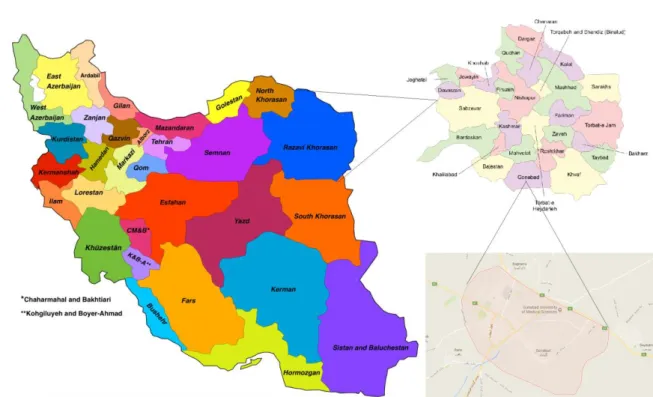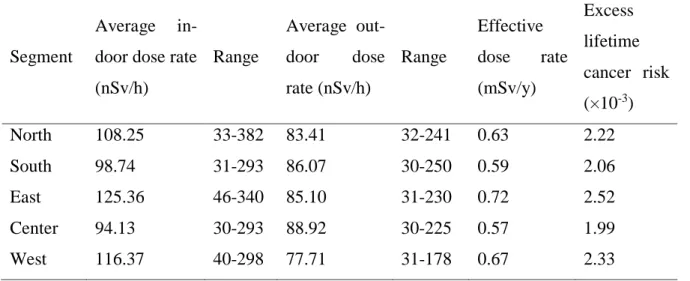BJRS
RADIATION SCIENCES
05-03 (2017) 01-07
Estimation of outdoor and indoor effective dose and excess
lifetime cancer risk from Gamma dose rates in Gonabad,
Iran
R, Jafari
a; A, Mohammadi
b; H, Zarghani
a*aParamedical faculty, Birjand University of Medical Sciences, Birjand, Iran
b Student Research Committee, Birjand University of Medical Sciences, Birjand, Iran e-mail address of the corresponding author: hmedicalphysics@gmail.com
ABSTRACT
Background gamma irradiation in the indoor and outdoor environments is a major concern in the world. The study area was Gonabad city. Three stations and buildings for background radiation measurement of outdoor and indoor were randomly selected and the Geiger-Muller detector (X5C plus) was used. All dose rates on display of survey meter were recorded and mean of all data in each station and buildings was computed and taken as measured dose rate of that par-ticular station. The average dose rates of background radiation were 84.2 nSv/h for outdoor and 108.6 nSv/h for indoor, maximum and minimum dose rates were 88.9 nSv/h and 77.7 nSv/h for outdoor measurements and 125.4 nSv/h and 94.1 nSv/h for indoor measurements, respectively. Results show that the annual effective dose is 0.64 mSv, which com-pare to global level of the annual effective dose 0.48 mSv is high. Estimated excess lifetime cancer risk was 2.24×10-3,
indicated that it is large compared to the world average value of 0.25×10-3.
Keywords: background gamma irradiation, indoor and outdoor environment, dose rate, annual effective dose and excess
1. INTRODUCTION
Natural environmental radiation investigation and measurement are of great importance and interest in health physics for practical and fundamental scientific reasons [1]. Background radiation ema-nates from primordial, cosmogenic and anthropogenic sources. Primaries are present in the earth's crust and existed all over the world, including man body itself. Cosmogenic radionuclides are born when highly energetic cosmic radiations come from sun. In that way galactic radiation strikes to atmosphere and they produce secondary radiation and uncharged particles such as protons, neu-trons, pions and low-Z nuclei. In turn, the secondary particles produce cascade particles in the at-mosphere [2]. Dose rate at the earth surface from these secondary radiations depend slightly on both elevation and latitude [3, 4]. Charged particles and the Earth's magnetic field cause the latitude ef-fect, which the Earth's magnetic field directs away ions from the equator toward the poles [4]. This dose rate changes atoms and molecules and may consequently damage living cells [5]. If a large number of cells killed because of the large dose rate, observable harm or organ failure will occur [5, 6]. The secondary particles directly interact with the Deoxyribonucleic acid (DNA) or indirectly through the production of free radicals and so leading to modification of the DNA by the breakage of the chemical bonds. Reproductive failure, mutation sometimes leading to transformed phenotype and possibly carcinogenesis, genetic damage in other body cells and delay in cell divi-sion may occur because of breakage or changes in the chemical bond in biological effects [7]. As a result, long time radiation exposure may cause excess cancers [5].
The aim of this study was measurements of background gamma radiation in the outdoor and indoor in the Gonabad city of Razavi province, Iran.
2. MATERIALS AND METHODS
The study area is Gonabad city, which is located in Razavi Khorasan Province of Iran (Fig. 1) with a total population of 36,367 (2011) (34°20'20"N 58°42'3"E). In order to measurement, the area map of the sites was divided into five segments as north, east, south, west and center. For each one, three stations and buildings were randomly selected for background radiation measurement of
out-door and inout-door. For each measurement the device was placed on an aluminum holder at one meter above the ground level for half an hour to avoid effects of the ground and buildings on outdoor and from the walls to satisfy criteria on indoor. Preferentially the ground level was grassy. Readings were obtained at the middle. Background dose rate was done in the second six months of 2016 and in each stations, background dose rate every minutes was read for 30 minutes.
For measurements, similar and common masonry buildings were selected and Geiger-Muller de-tector (X5C plus) was used that calibrated by manufacturer for a period of two years. All dose rates on display of survey meter were recorded. The mean of all data in each station and buildings was computed and taken as measured dose rate of that particular station. Using measured data, annual effective dose of background radiation was estimated as follows [8]:
E=(Dout×OFout+Din×OFin)×T× f, (1)
where E (nSv) is the annual effective dose, Dout and Din (nSv/h) are mean outdoor and indoor
ab-sorbed dose rates, T (h) is time to convert from year to hour (24hours×365.25), OFout and OFin are
outdoor and indoor occupancy factors (20% and 80% for outdoor and indoor, respectively) and f is conversion coefficient (0.7 for adults) reported by The United Nation Scientific Committee on the Effect of Atomic Radiation (UNSCEAR) to convert absorbed dose in air to the effective dose [9].
It is necessary to measure excess lifetime cancer risk because gamma radiation provide infor-mation on this parameter [10]. Based on the annual effective dose, excess lifetime cancer risk is calculated as follows [11]:
Excess lifetime cancer risk= E× mean duration of life (DL) ×risk factor (RF) (2)
Where E is the annual effective dose, DL is duration of life (70 years) and RF is risk factor (Sv-1) or fatal cancer risk per Sievert. The constant 0.05 for the public exposure is used by ICRP (Interna-tional Commission on Radiological Protection) for stochastic effects [12].
3. RESULTS
The mean background radiation dose rates of outdoor and indoor, corresponding effective dose rates and excess lifetime cancer risk in five segments of Gonabad city are summarized in Table 1. Based on the results, the average dose rate were 84.2 nSv/h and 108.6 nSv/h, maximum and minimum dose rates were 88.9 nSv/h and 77.7 nSv/h and 125.4 nSv/h and 94.1 nSv/h for outdoor and indoor background radiation, respectively.
Using indoor and outdoor dose rates of background radiation and equation 1, estimated annual ef-fective dose of adults in Gonabad city was calculated as below:
E= (84.2×0.2+108.6×0.8) ×8766×0.7=0.64 mSv/y.
By using equation (2), excess lifetime cancer risk was calculated as below: Excess lifetime cancer risk=0.64×70×0.05=2.24×10-3.
Table 1 average outdoor and indoor background dose rates, achieved effective dose and excess
life-time cancer risk in selected segments of Gonabad city
Segment
Average in-door dose rate (nSv/h) Range Average out-door dose rate (nSv/h) Range Effective dose rate (mSv/y) Excess lifetime cancer risk (×10-3) North South East Center West 108.25 98.74 125.36 94.13 116.37 33-382 31-293 46-340 30-293 40-298 83.41 86.07 85.10 88.92 77.71 32-241 30-250 31-230 30-225 31-178 0.63 0.59 0.72 0.57 0.67 2.22 2.06 2.52 1.99 2.33
4. DISCUSSION
Background radiation studies are of great importance that are measured in most countries [3]. A G.M detector (X5C plus) is used for obtaining the results of this study. The results obtained by this detector illustrated that the mean outdoor and indoor dose rates in selected area were about 84.2 and 108.6 nSv/h, respectively. These values are due the terrestrial radioactive sources and the cosmic rays [8]. These results, in comparison with the outdoor values of other cities in Iran and different countries is high, such as Bushehr, 51.8 nSv/h, Chabok sar, 71 nSv/h, Kela Chay, 65 nSv/h, Pareh Sar, 67 nSv/h. The Netherlands, Cyprus, Iceland, Egypt and United Kingdom were less than 40 nSv/h. Our results were lower than the values such as Isfahan, 137 nSv/h, Lorestan province, 113 nSv/h, Gilan province, 94 nSv/h and Oromeih, 154 nSv/h. Australia, Malaysia, and Portugal were greater than 80 nSv/h [8, 13-16].
As reported by UNSCEAR, environmental Gamma radiation average for adults worldwide is 0.48 mSv that individual country results were within the 0.3-0.6 mSv range. The values are about 10% and 30% higher for children and infants [8].
As achieved for excess lifetime cancer risk which is 2.24×10-3, it is large as compared to the world
average value of 0.25×10-3 [8]. This is due to terrestrial nuclear radiation.
According to our previous paper [2], the average dose rate of background radiation was 71.8 nSv/h for outdoor and 82.0 nSv/h for indoor. The annual effective dose and estimated excess lifetime can-cer risk was 0.49 mSv and 1.715×10-3, respectively. With regard to altitude, the higher altitude re-gions have higher background gamma radiation levels [15]. Therefore, higher background gamma radiation level in Gonabad may be because of soil type. Altitude of birjand city is 1491 meters in-stead of 1093 meters of Gonabad city.
5. CONCLUSION
Natural environmental radiation investigation and measurement are of great importance and interest in health physics for practical and fundamental scientific reasons. Results show that the annual ef-fective dose is 0.64 mSv, which compared to global level of the annual efef-fective dose 0.48 mSv is high. Estimated excess lifetime cancer risk was 2.24×10-3, indicated that it is large as compared to the world average value of 0.25×10-3.
REFERENCES
[1] Shahbazi-Gahrouei, D. Natural background radiation dosimetry in the highest altitude region of Iran. J Radiat Res. 2003 Sep, 44(3):285-7.
[2] Zarghani, H; Jafari, R. Assessment of Outdoor and Indoor Background Gamma Radiation, the Annual Effective Dose and Excess Lifetime Cancer Risk in Birjand, Iran. Jundishapur J Health
Sci. Inpress (Inpress):e40791.
[3] Bouzarjomehri, F; Ehrampoush, M. H. Gamma background radiation in Yazd province A pre-liminary report . Iranian Journal of Radiation Research (IJRR). 2005; 3 (1):17-20.
[4] Shahbazi-Gahrouei, D. Annual background radiation in Chaharmahal and Bakhtiari province; Iran. J. Radiat. Res. 2003, 1(2): 87 – 91.
[5] Tavakoli, MB. Annual radiation background in the City of Isfahan. Med Sci Monit. 2003 Jul, 9(7):PH7-10.
[6] Dutreix, MTJ; Wambersie, A. Introduction to Radiobiology. Translated by Bewley DK,
Bur-gess Sciences Press, UK, 1990.
[7] Franklin, AA; Daniel, AF. Assessment of background Gamma radiation level in farmlands in ethiope east local government area of delta state, Nigeria. Nigerian J Physic. 2014, 25(2 ):85-91. [8] United Nations Scientific Committee on the Effects of Atomic Radiation. ANNEX B: Expo-sures from natural radiation sources, sub subsection IIC2. (2000).
[9] United Nations Scientific Committee on the Effects of Atomic Radiation. Sources and effects of ionizing radiation: sources. Vol. 1. United Nations Publications, 2000.
[10] Rashed-Nizam, Q M; et al. Assessment of radionuclides in the soil of residential areas of the Chittagong metropolitan city, Bangladesh and evaluation of associated radiological risk. Journal of
radiation research (2014): rru073.
[11] Taskin, H; et al. Radionuclide concentrations in soil and lifetime cancer risk due to gamma radioactivity in Kirklareli, Turkey. Journal of environmental radioactivity. 100.1 (2009): 49-53. [12] The 2007 Recommendations of the International Commission on Radiological Protection. Ann, ICRP 37. ICRP Publication 103, 2007.
[13] Pashazadeh, A M; et al. Annual effective dose from environmental gamma radiation in Bu-shehr city. Journal of Environmental Health Science and Engineering. 12.1 (2014): 1.
[14] Basirjafari, S; et al. Assessment of outdoor gamma radiation dose rates in 49 cities of Guilan province, IRAN. Iranian Journal of Medical Physics. 11.1 (2014): 168-174.
[15] Gholami, M; Mirzaei, S, Jomehzadeh, A. Gamma background radiation measurement in Lorestan province, Iran. Iran J Rad Res. 9 (2011): 89-93.
[16] Basirjafari, S; Aghayari, S; Poorabas, S M; Moladoust, H; Asadinezhad M. Assessment of Outdoor Gama Radiation Dose Rates in 49 Cities of Guilan Province, IRAN. Iranian Journal of

